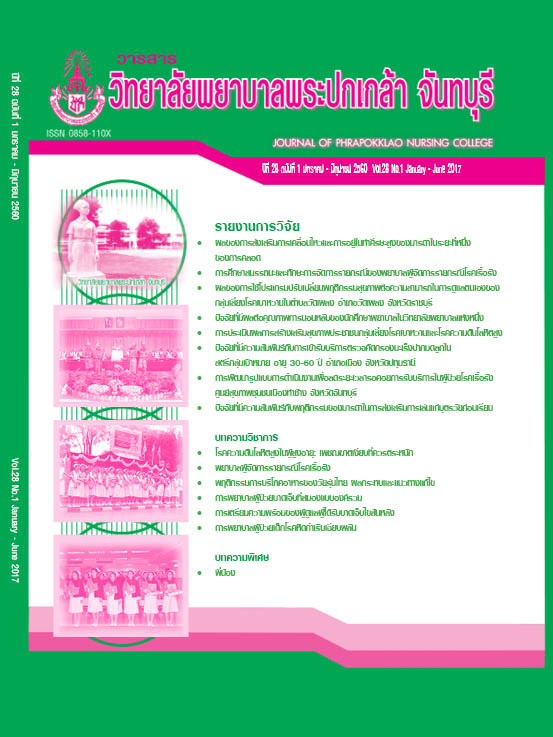The Effects of Promoting Maternal Mobility and Upright Positions during the First Stage of Labor
Keywords:
Maternal mobility, Upright position, The first stage of laborAbstract
The purpose of this quasi-experimental research was to study the effects of promoting maternal mobility and upright positions during the first stage of labor. The samples consisted of 50 mothers giving birth for the first time at Chiang Yuen Hospital, Mahasarakham Province, who were equally separated into an experimental group and a control group. The experimental group were promoted with the maternal mobility and upright positions during the first stage of labor with the conventional nursing care and the control group received only the conventional nursing care. The research instruments consisted of the visual media and the manual for promoting the maternal mobility and upright positions during the first stage of labor, the data recording form, the recording form of mobility and upright positions, and the birth outcomes recording form. The implementation and data collection were conducted from December, 2014 to May, 2016. Statistics used for data analysis included frequency, percentage, mean, standard deviation, and independent t-test.
The result revealed that the experimental group had statistically significant shorter average time of the first stage of labor than that of the control group (t = 2.049, p < .05).
This study suggested that mothers should be encouraged to have mobility and upright positions during the first stage of labor in order to shorten the labor time. This will reduce the time that mothers have to face with the pain during the first stage of labor and reduce fatigue from waiting for giving birth for a long time.
References
ขวัญใจ เพทายประกายเพชร, ฉวีวรรณ อยู่สำราญ, และวรรณา พาหุวัฒนกร. (2558). ผลของการบริหารการหายใจร่วมกับการจัดท่าศีรษะสูงต่อความเจ็บปวดและระยะเวลาการคลอดในผู้คลอดครรภ์แรก. วารสารวิทยาลัยพยาบาลพระปกเกล้า จันทบุรี, 26(2), 52-62.
Albers, L. L. (2007). The evidence for physiologic management of the active phase of the first stage of labor. Journal of Midwifery & Women’s Health, 52(3), 207-215.
Baker, K. (2010). Midwives should support women to mobilize during labour. British Journal of Midwifery, 18(8), 492-497.
Bloom, S. L., et al. (1998). Lack of effect of walking on labor and delivery. The New England Journal of Medicine, 399(2), 76-79.
Cheng, Y. W., Shaffer, B. L., Bryant, A. S., & Caughey, A. B. (2010). Length of the first stage of labor and associated perinatal outcomes in nulliparous women. Obstetrics & Gynecology, 116(5), 1127-1135.
Gizzo, S., Di Gangi, S., Noventa, M., Bacile, V., Zambon, A., & Nardelli, G. B. (2014). Women’s choice of positions during labour: Return to the past or a modern way to give birth? A cohort study in Italy. BioMed Research International, e1-e7. Retrieved June 1, 2016, from http://dx.doi.org/10.1155/2014/638093
Lawrence, A., Lewis, L., Hofmeyr, G. J., Dowswell, T., & Styles, C. (2009). Maternal positions and mobility during first stage labour. Cochrane Database of Systematic Reviews 2009, Issue 2. Art. No.: CD003934. DOI: 10.1002/14651858.CD003934.pub2.
Lawrence, A., Lewis, L., Hofmeyr, G. J., & Styles, C. (2013). Maternal positions and mobility during first stage labour. Cochrane Database of Systematic Reviews 2013, Issue 8. Art. No.: CD003934. DOI: 10.1002/14651858.CD003934.pub3.
Martin, H. C. J., & Martin, C. R. (2013). A narrative review of maternal physical activity during labour and its effects upon length of first stage. Complementary Therapies in Clinical Practice, 19(1), 44-49.
Miquelutti, M. A., Cecatti, J. G., & Makuch, M. Y. (2007). Upright position during the first stage of labor: Arandomised controlled trial. Acta Obstetriciaet Gynecologica, 86(5), 553-558.
Priddis, H., Dahlen, H., & Schmied, V. (2012). What are the facilitators, inhibitors, and implications of birth positioning? A review of the literature. Women and Birth, 25(3), 100-106.
Romano, A. M., & Lothian, J. A. (2008). Promoting, protecting, and supporting normal birth: A look at the evidence. Journal of Obstetric, Gynecologic, & Neonatal Nursing, 37(1), 94-105.
Souza, J. P., Miquetutti, M. A., Cecatti, J. G., & Makuch, M. Y. (2006). Maternal position during the first stage of labor: A systematic review. Reproductive Health, 3(10), e1-e9. Retrieved January 16, 2016, from http://www.reproductve-health-journal.com Doi:10.1186/1742-4755-3-10
World Health Organization. (1996). Maternal and newborn health/safe motherhood unit. Care in normal birth: A practical guide. Geneva, Switzerland: Department of Reproductive Health and Research. Retrieved June 1, 2016, from http://dx.doi.org/10.1155/2014/638093
Downloads
Published
How to Cite
Issue
Section
License
Copyright (c) 2017 Journal of Phrapokklao Nursing College

This work is licensed under a Creative Commons Attribution-NonCommercial-NoDerivatives 4.0 International License.
เนื้อความ ข้อมูล และรายการอ้างอิงที่ผู้เขียนใช้ในการเขียนบทความเพื่อลงตีพิมพ์ในวารสารวิทยาลัยพยาบาลพระปกเกล้า จันทบุรี ถือเป็นความคิดเห็นและความรับผิดชอบของผู้เขียน คณะผู้จัดทำวารสารไม่จำเป็นต้องเห็นพ้องด้วยหรือร่วมรับผิดชอบ
บทความที่ได้รับการลงตีพิมพ์ในวารสารวิทยาลัยพยาบาลพระปกเกล้า จันทบุรี ถือเป็นลิขสิทธิ์ของวารสารวิทยาลัยพยาบาลพระปกเกล้า จันทบุรี หากหน่วยงานหรือบุคคลใดต้องการนำส่วนหนึ่งหรือทั้งหมดของบทความไปเผยแพร่ต่อเพื่อวัตถุประสงค์ใด ๆ จะต้องได้รับอนุญาตจากบรรณาธิการวารสารก่อน



